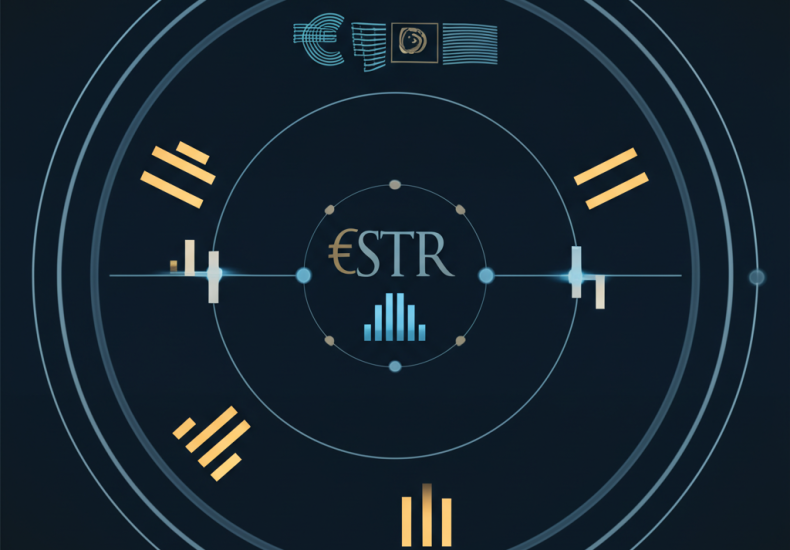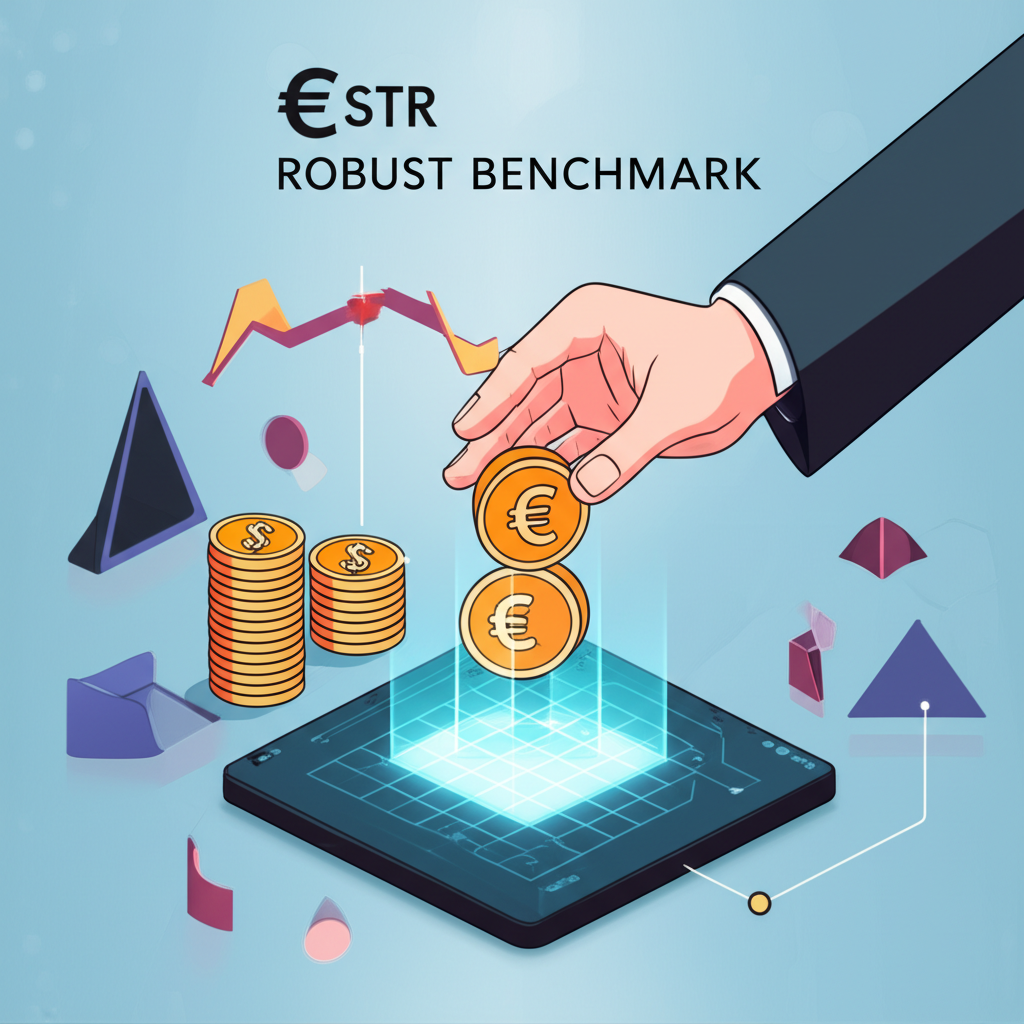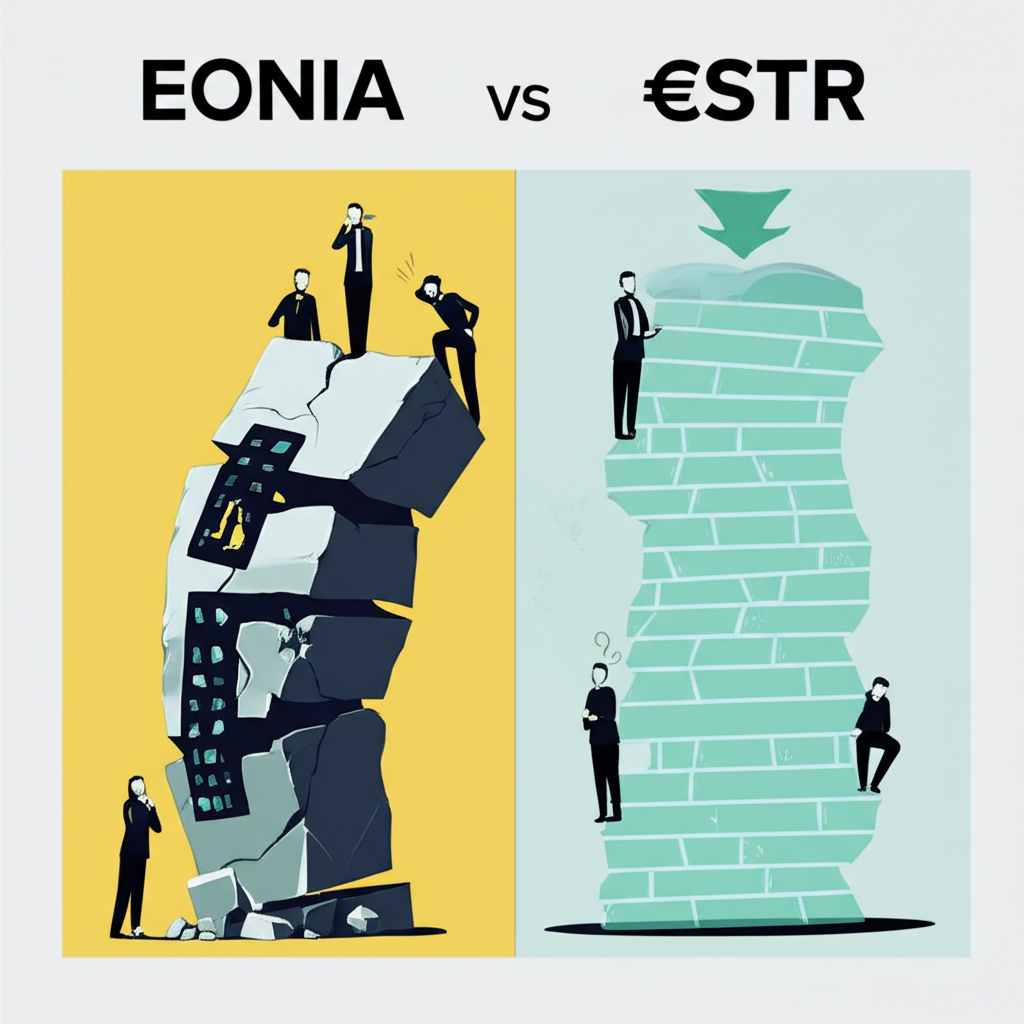
Euro Short-Term Rate: What is €STR and Why Does it Matter for Your Investments?
Table of Contents
ToggleIntroduction to the Euro Short-Term Rate (€STR)

The Euro Short-Term Rate, or €STR, has become a foundational benchmark in the Eurozone’s financial ecosystem, providing a transparent and reliable measure of overnight unsecured borrowing costs among banks and other financial institutions. Launched by the European Central Bank in October 2019, it was designed to replace the outdated EONIA rate and address growing concerns about the integrity of interbank benchmarks. Unlike earlier indices that relied on estimated submissions, €STR is grounded in real transaction data, making it far more resilient to manipulation and better aligned with actual market conditions. As a key reference point for money markets, derivatives, and lending products, €STR plays a pivotal role in shaping how monetary policy is transmitted across the region. This article provides an in-depth exploration of its structure, function, and influence on both financial markets and the broader economy.
What is €STR? Definition and Core Purpose

At its core, the Euro Short-Term Rate reflects the average interest rate at which financial institutions in the euro area borrow funds on an unsecured basis overnight. It is not an estimate or a quote but a data-driven rate calculated from real transactions, ensuring high credibility and accuracy. The ECB developed €STR to serve as a risk-free reference rate—one that captures the true cost of short-term funding without the distortions introduced by subjective inputs. Its primary purpose extends beyond mere measurement; it supports financial stability, enhances market transparency, and strengthens the transmission of monetary policy. Because it’s based on actual wholesale market activity, €STR offers a clearer picture of liquidity conditions than its predecessors. For authoritative details on its scope and methodology, visit the ECB Euro Short-Term Rate page.
Why Was €STR Introduced? The Transition from EONIA

The shift from EONIA to €STR was driven by a global push for reform following widespread manipulation of benchmark interest rates like LIBOR. EONIA, once the dominant overnight rate in the eurozone, had become increasingly unreliable. With shrinking transaction volumes and dependence on a limited panel of banks, it no longer reflected genuine market dynamics. Moreover, its susceptibility to manipulation undermined trust in financial benchmarks. In response, the ECB partnered with the private sector and regulatory bodies to develop a new standard—one rooted in verifiable data rather than expert judgment. €STR emerged as that solution. While EONIA was based on interbank lending estimates, €STR draws from a broader pool of transactions involving banks, money market funds, central counterparties, and non-financial corporations. This wider scope makes it more representative and resilient. On average, €STR runs about 8.5 basis points below the old EONIA rate, reflecting differences in both methodology and market composition.
How is €STR Calculated? Methodology and Data Sources

The calculation of €STR follows a rigorous, rules-based process designed to ensure fairness, accuracy, and resilience. Every TARGET2 business day, the ECB collects confidential transaction data from all monetary financial institutions (MFIs) in the euro area that are subject to the Money Market Statistical Reporting (MMSR) framework. These reports include details of unsecured overnight deposits made with other financial entities, governments, and large non-financial corporations. From this dataset, the ECB applies a “volume-weighted trimmed mean” methodology. First, all eligible transactions are weighted by their size. Then, the top and bottom 25% of transaction volumes—excluding extreme outliers—are removed to prevent distortion from unusual trades. The final rate is derived from the remaining core transactions, ensuring it reflects typical market behavior. The result is published daily at 08:00 CET, offering market participants a timely and trustworthy benchmark.
Key Features of €STR Methodology
One of the most significant innovations in the €STR framework is its inclusion of a diverse range of counterparties beyond traditional interbank lending. By incorporating transactions with money market funds, investment vehicles, and central counterparties, the rate captures a more complete view of overnight funding pressures. This broader coverage increases its representativeness and reduces the risk of bias. The trimmed mean approach further strengthens reliability by filtering out volatile or atypical trades, even if they are large in value. Unlike models that average all reported rates, this method prioritizes the central tendency of the market. The ECB’s role is central to the process—not only does it oversee data collection and validation, but it also independently calculates and publishes the rate, reinforcing its neutrality and public trust. This institutional oversight ensures €STR remains free from commercial influence and consistent with regulatory standards.
€STR vs. EURIBOR: Understanding the Key Differences
Although both €STR and EURIBOR are essential benchmarks in the euro financial system, they serve different functions and reflect distinct market realities. While €STR is an overnight, transaction-based rate considered close to risk-free, EURIBOR represents the rates at which banks lend to one another across various maturities—and includes a credit risk premium. This distinction leads to important differences in usage and behavior.
| Feature | €STR (Euro Short-Term Rate) | EURIBOR (Euro Interbank Offered Rate) |
|---|---|---|
| Underlying Market | Unsecured overnight borrowing from a broad range of financial counterparties (banks, money market funds, etc.). | Unsecured interbank lending across multiple maturities (1-week, 1-month, 3-month, etc.). |
| Calculation Methodology | Transaction-based, volume-weighted trimmed mean of actual overnight unsecured deposit transactions. | Panel bank submissions (quoted rates) for lending to other prime banks. |
| Risk Premium | Primarily reflects credit risk of the broader financial system; generally considered “risk-free” or near risk-free. | Includes a bank credit risk premium (banks lending to each other). |
| Maturity | Overnight only. | Various maturities, from 1-week to 12-months. |
| Administrator | European Central Bank (ECB). | European Money Markets Institute (EMMI). |
Because EURIBOR incorporates both term and credit risk, it typically trades higher than €STR. For instance, the 3-month EURIBOR includes expectations about future rate changes and the perceived risk of bank defaults over that period. In contrast, €STR provides a cleaner signal of current funding conditions. As a result, €STR has become the preferred rate for overnight indexed swaps and risk management tools, while EURIBOR remains widely used in consumer loans, mortgages, and corporate financing.
Implications for Financial Products and Markets
The coexistence of €STR and EURIBOR enables market participants to choose the most appropriate benchmark based on product type and risk profile. €STR’s robustness and transparency have made it the standard for overnight indexed swaps (OIS), which are critical for hedging short-term interest rate exposure. Financial institutions increasingly use compounded versions of €STR—calculated over one, three, or six months—to create synthetic term rates for loans and bonds. These compounded rates retain the integrity of the underlying overnight index while accommodating longer interest periods. Meanwhile, EURIBOR continues to anchor trillions of euros in legacy contracts and retail financial products. However, new issuances are gradually shifting toward €STR-based references, especially in derivatives and institutional lending. This evolution reflects a broader trend toward benchmarks that are less prone to manipulation and more reflective of actual market activity.
Historical Trends and Current Euro Short-Term Rate Data
Since its debut in late 2019, €STR has tracked the ECB’s monetary policy trajectory with remarkable consistency. Initially negative, mirroring the central bank’s accommodative stance during a period of low inflation and economic stagnation, the rate began rising in 2022 as the ECB responded to surging inflation following geopolitical shocks and post-pandemic imbalances. The shift from negative to positive territory marked a turning point in the Eurozone’s monetary policy cycle. Throughout this period, €STR has demonstrated stability and responsiveness, validating its role as a reliable benchmark. Its daily movements often align closely with changes in the ECB’s key policy rates, particularly the deposit facility rate, which serves as a floor for overnight funding costs.
Analyzing €STR Charts and Data Sources
To understand the behavior of €STR over time, analysts rely on visual tools such as line charts that highlight trends, volatility, and correlations with macroeconomic events. Sharp upward spikes often coincide with ECB rate hikes or liquidity tightening, while sustained declines reflect easing cycles. Observing the spread between €STR and other rates—like the main refinancing operations rate or EONIA before its discontinuation—can reveal shifts in market confidence or funding stress. Two primary sources provide comprehensive access to historical and real-time data: the European Central Bank’s official statistics portal and the Federal Reserve Economic Data (FRED) platform. Both offer downloadable datasets, interactive graphs, and contextual commentary, enabling users to conduct detailed analysis and benchmark comparisons.
The Broader Impact of €STR on the Eurozone Economy
Beyond its technical function as a benchmark, €STR plays a vital role in shaping the economic environment across the Eurozone. As a primary channel for monetary policy transmission, it directly influences the cost of borrowing for banks, which in turn affects lending rates for households and businesses. When the ECB adjusts its policy stance, the impact is quickly felt in the €STR, which then ripples through the financial system. A rising €STR can increase financing costs for investment and consumption, potentially slowing economic growth and inflation. Conversely, a declining rate lowers borrowing costs, encouraging spending and investment. Because €STR is based on actual transactions and is administered by a trusted central authority, its movements are seen as credible signals of monetary conditions. This reliability enhances predictability in financial planning and supports macroeconomic stability.
Forecasting €STR: Models and Market Expectations
Predicting the future path of €STR is a key concern for investors, lenders, and policymakers alike. Since the rate closely follows the ECB’s policy decisions, forecasts often begin with an assessment of the central bank’s likely trajectory. Market-based indicators such as overnight indexed swaps (OIS) and forward rate agreements (FRAs) embed collective expectations about future rate levels and are widely used as forecasting tools. For example, the price of a 3-month €STR OIS reflects the market’s consensus on where the average overnight rate will settle over that period. In addition to derivatives data, economists analyze macroeconomic fundamentals—including inflation trends, labor market data, and GDP growth—to anticipate ECB policy moves. Central bank communications, such as speeches by Governing Council members and meeting minutes, also provide valuable forward guidance. However, uncertainty remains—especially during periods of economic volatility or unexpected shocks—which means forecasts should always account for a range of possible outcomes.
How Investors Use €STR Forecasts
Investors integrate €STR forecasts into a variety of decision-making processes. Fixed-income managers use them to evaluate the attractiveness of floating-rate bonds, particularly those tied to compounded €STR. Institutions with large cash reserves rely on rate projections to optimize returns in money market funds and short-term deposits. For corporations managing variable-rate debt, accurate forecasts help in planning capital expenditures and assessing interest expenses. In derivatives trading, expectations about future €STR movements inform strategies involving interest rate swaps, futures, and options. A company anticipating higher rates, for instance, might enter into a pay-fixed/receive-floating swap to lock in current rates and reduce exposure. Similarly, asset allocators may adjust portfolio duration or shift between fixed and floating-rate instruments based on their outlook for short-term rates.
Legal and Contractual Implications of €STR Adoption
The transition from EONIA to €STR has required extensive legal and operational adjustments across the financial industry. Thousands of existing contracts—including syndicated loans, bonds, and over-the-counter derivatives—originally referenced EONIA as their benchmark. As EONIA was phased out at the start of 2022, these agreements needed to be amended to incorporate €STR or a suitable fallback mechanism. This process, known as “re-papering,” posed logistical and legal challenges, especially for long-dated instruments with complex terms. To streamline the transition, industry groups such as the Working Group on Euro Risk-Free Rates provided standardized templates and fallback language. These recommendations helped ensure consistency and reduce disputes.
Impact on Loan Agreements and Derivatives
In loan documentation, the switch to €STR often involves replacing EONIA with a compounded version of the overnight rate, calculated arithmetically over the interest period. Because €STR is slightly lower than EONIA on average, a credit adjustment spread (CAS) is typically added to maintain economic neutrality—ensuring neither party gains an unintended advantage. In the derivatives market, the shift has been more seamless. The International Swaps and Derivatives Association (ISDA) introduced its IBOR Fallbacks Protocol, which automatically updates legacy contracts to reference €STR plus a spread upon the cessation of EONIA. This standardized approach has minimized disruption and supported the rapid adoption of €STR OIS as the new benchmark for short-term interest rate hedging. Today, the vast majority of new euro-denominated swaps are indexed to €STR.
Investing in €STR-Linked Products
As €STR gains prominence, a growing array of financial instruments now use it as a reference rate, offering investors direct exposure to short-term euro funding conditions. These products combine transparency with low credit risk, making them attractive for conservative portfolios and liquidity management.
- Short-Term Floating-Rate Bonds: Governments and corporations are increasingly issuing bonds with coupons tied to compounded €STR. These instruments provide variable income that adjusts with market rates, reducing duration risk compared to fixed-rate bonds.
- Money Market Funds (MMFs): Many euro-denominated MMFs now base their net asset value calculations on €STR-linked assets. These funds offer high liquidity and minimal volatility, serving as a safe haven for institutional and retail cash.
- Exchange-Traded Funds (ETFs): Though less common, some ETFs focus on short-term interest rate strategies and may include €STR-linked derivatives or money market instruments in their portfolios, providing diversified access to the benchmark.
- Derivatives: Beyond OIS, futures and options on €STR are available on major exchanges, enabling sophisticated risk management and speculative positioning.
While these investments benefit from the credibility of a transaction-based benchmark, they are not without risk. Interest rate fluctuations can affect returns, issuer credit quality remains a consideration for bonds, and liquidity may vary depending on market conditions. As with any financial decision, investors should align their choices with their risk tolerance and financial goals.
Conclusion: The Enduring Role of €STR in Global Finance
The Euro Short-Term Rate has evolved from a regulatory response to a benchmark scandal into a cornerstone of modern financial infrastructure in the Eurozone. By anchoring itself in real transaction data and broad market participation, €STR delivers a level of transparency and reliability that previous benchmarks could not match. It supports effective monetary policy, strengthens financial stability, and enables fairer pricing of loans, bonds, and derivatives. As markets continue to adapt to a post-IBOR world, €STR stands out as a model of reform done right—resilient, independent, and forward-looking. Its growing use in investment products and cross-border contracts underscores its importance not just within Europe but in global finance as a whole. With central banks and regulators committed to its integrity, €STR is poised to remain a trusted benchmark for years to come.
Frequently Asked Questions about €STR
1. What is the current Euro short-term rate today?
The current Euro short-term rate (€STR) is published every TARGET2 business day at 08:00 CET, reflecting the previous day’s trading activity. For the most up-to-date rate, please refer directly to the European Central Bank’s official €STR page.
2. How does the Euro short-term rate (€STR) differ from EURIBOR?
€STR is a transaction-based overnight rate reflecting unsecured borrowing costs from a broad range of financial counterparties, administered by the ECB. EURIBOR is a panel-based rate reflecting unsecured interbank lending rates across multiple maturities (1-week to 12-months), administered by EMMI. EURIBOR typically includes a bank credit risk premium, making it generally higher than €STR.
3. Why was €STR introduced, and what was its predecessor?
€STR was introduced to replace EONIA (Euro OverNight Index Average) following benchmark manipulation scandals and concerns about EONIA’s robustness and representativeness due to declining underlying market activity. €STR provides a more transparent and transaction-based benchmark.
4. Where can I find historical data and charts for the Euro short-term rate?
Historical data and charts for €STR can be found on the European Central Bank’s website and the Federal Reserve Economic Data (FRED) database.
5. What is the significance of €STR for the Eurozone economy and financial markets?
€STR is crucial for monetary policy transmission, influencing interbank lending, corporate borrowing costs, and overall economic activity. In financial markets, it serves as a robust reference rate for overnight indexed swaps, derivatives, and a growing number of loans and bonds, enhancing transparency and stability.
6. Are there any investment products, like ETFs, linked to the Euro short-term rate?
Yes, there are several investment products linked to €STR. These include short-term bonds with floating rates referencing €STR, money market funds that invest in €STR-linked instruments, and certain derivatives. While less common, some ETFs may also track baskets of €STR-linked assets.
7. How is the €STR 3-month rate related to the overnight €STR?
The overnight €STR is the base rate. A “€STR 3-month rate” is not a directly published rate but is typically a compounded version of the daily overnight €STR over a three-month period. This compounded rate is used in financial products that require a term rate while still leveraging the robustness of the overnight €STR.
8. What are the main factors that influence the Euro short-term rate forecast?
Key factors influencing €STR forecasts include:
- ECB monetary policy decisions (e.g., policy rate changes, quantitative easing/tightening).
- Economic indicators (inflation, GDP growth, employment).
- Market expectations embedded in forward rates (e.g., OIS).
- Central bank guidance and communications.
9. What is the role of the European Central Bank (ECB) in relation to €STR?
The ECB is the administrator of €STR. Its role includes collecting the underlying transaction data, calculating the rate using its volume-weighted trimmed mean methodology, and publishing the daily rate. The ECB also oversees the integrity and robustness of the benchmark.
10. What are the legal implications of the transition to €STR for financial contracts?
The transition necessitated extensive re-papering of legacy contracts that referenced EONIA, requiring parties to amend agreements to refer to €STR or a suitable compounded €STR-based rate. It also involved implementing robust fallback provisions to address scenarios where a benchmark might cease to exist or become non-representative.
You may also like
Calendar
| 一 | 二 | 三 | 四 | 五 | 六 | 日 |
|---|---|---|---|---|---|---|
| 1 | 2 | 3 | 4 | 5 | 6 | 7 |
| 8 | 9 | 10 | 11 | 12 | 13 | 14 |
| 15 | 16 | 17 | 18 | 19 | 20 | 21 |
| 22 | 23 | 24 | 25 | 26 | 27 | 28 |
| 29 | 30 | 31 | ||||
發佈留言
很抱歉,必須登入網站才能發佈留言。